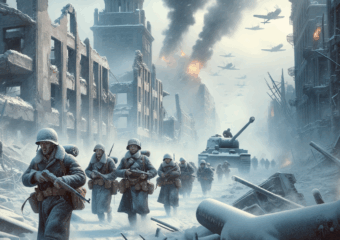The Battle of Stalingrad, fought between August 1942 and February 1943, was one of the most significant confrontations of World War II. It not only marked a pivotal shift in the conflict on the Eastern Front but also came to symbolize the grit and sacrifice that characterized 20th-century warfare. This massive engagement between Nazi Germany and the Soviet Union changed the trajectory of the war — and history itself.
The Context
By the summer of 1942, the German army had already conquered vast swathes of Europe and was advancing deep into Soviet territory. Adolf Hitler’s ambition to seize the oil fields of the Caucasus led to the decision to capture Stalingrad, a strategic industrial city on the Volga River. For the Soviets, defending the city named after Joseph Stalin was as much about morale and propaganda as it was about military significance.
The Battle Unfolds
The German Sixth Army, under General Friedrich Paulus, launched an aggressive campaign to take the city. They initially succeeded in pushing into Stalingrad, reducing it to rubble through constant bombardment. However, urban warfare proved costly and slow. Soviet forces, led by General Vasily Chuikov, engaged in fierce, close-quarter combat from street to street, often from building to building.
In November 1942, the Soviets launched Operation Uranus — a massive counteroffensive that encircled the German forces. Despite Hitler’s order to stand firm, the Sixth Army was cut off and starved of reinforcements and supplies. In February 1943, Paulus surrendered. It was the first time a German field marshal had surrendered in combat.
Human Cost and Historical Impact
- Estimated casualties exceeded two million, including soldiers and civilians.
- The Soviet Union suffered immense destruction but emerged with renewed morale.
- The German military began a slow, continuous retreat on the Eastern Front.
- The battle marked a clear turning point, boosting Allied confidence worldwide.
Legacy in Modern Culture
Stalingrad remains a symbol of resilience and tragedy. It has been depicted in numerous films, books, and documentaries. The ruins of the city and the Mamayev Kurgan memorial stand as stark reminders of the sacrifice made there. Military historians continue to study the battle for its tactical lessons and its psychological warfare elements.
Comparison with Other Major Battles
| Battle | Year | Casualties | Strategic Outcome |
|---|---|---|---|
| Battle of the Somme | 1916 | 1.2 million | Inconclusive, heavy loss for little gain |
| Battle of Midway | 1942 | ~3,500 | Major U.S. naval victory over Japan |
| Battle of Stalingrad | 1942–1943 | 2 million+ | Decisive Soviet victory, turning point on Eastern Front |
A Surprising Connection to Online Culture
While the brutality of Stalingrad feels far removed from modern life, the fascination with strategy, endurance, and mental discipline continues in new forms — even in areas like gaming. Strategic war simulations and tactical thinking have become part of many online experiences. Interestingly, some modern gaming platforms — including those not strictly focused on war games — share themes of risk, analysis, and perseverance. A good example of such platforms is https://surewin168.com, which emphasizes decision-making under pressure and calculated risk in a gaming environment. It’s a reminder that our competitive instincts and interest in tactics persist across generations.
Conclusion
The Battle of Stalingrad stands as one of the most impactful events of the 20th century. It was not only a military disaster for the Nazis but also a powerful symbol of determination and sacrifice. Its lessons — about courage, leadership, and the price of ambition — continue to echo today. Whether through historical study or the strategic games we play, Stalingrad’s legacy remains an enduring part of our collective consciousness.





